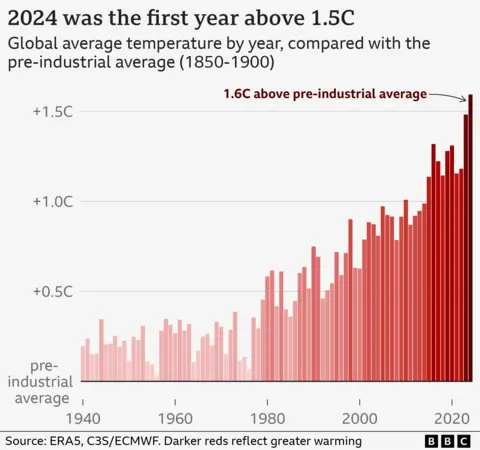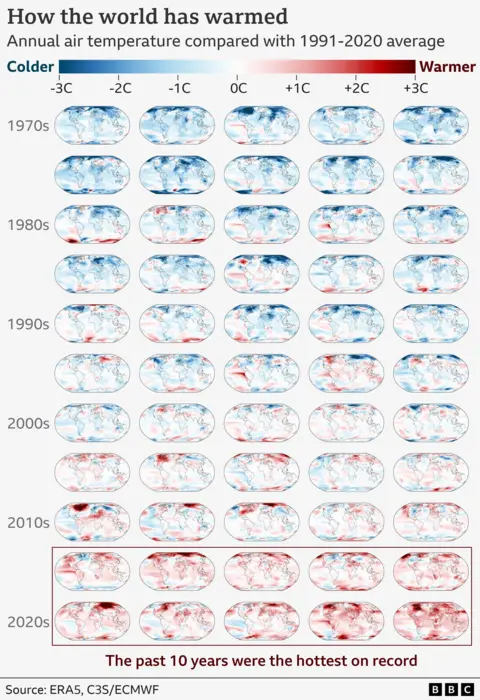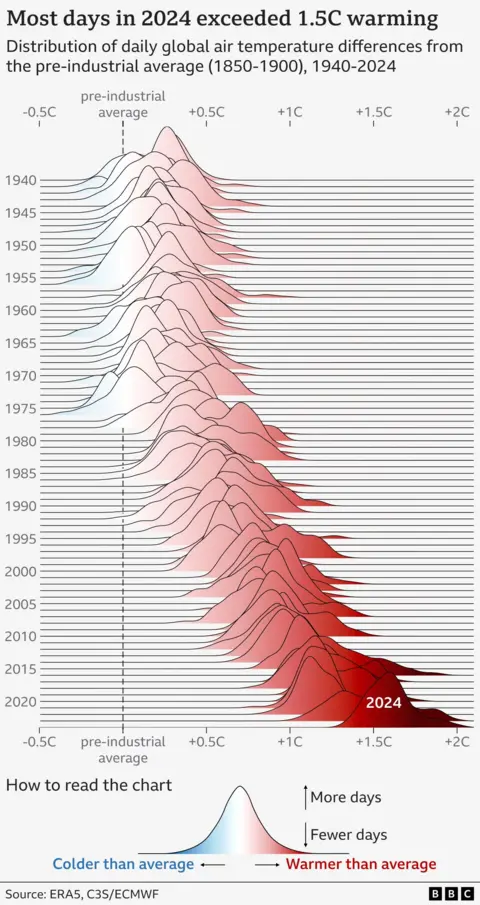 BBC
BBCThe planet is a big step closer to warming of more than 1.5 degrees Celsius, new data show, even as world leaders vowed a decade ago they would try to avoid it.
The European Copernicus Climate Service, one of the main global data providers, said Friday that 2024 is the first calendar year to exceed the symbolic threshold, as well as the world's hottest year on record.
This does not mean that the international 1.5C target has been breached, as it refers to the long-term average over decades, but brings it closer to doing so as fossil fuel emissions continue to warm the atmosphere.
Last week UN chief Antonio Guterres described the recent temperature record as a “climate breakdown”.
“We must get off this road to destruction – and we have no time to lose,” he said in his New Year's message, calling on countries to cut greenhouse gas emissions by 2025.

The global average temperature in 2024 was about 1.6C higher than in the pre-industrial era – the time when humans started burning large amounts of fossil fuels – according to the Copernicus data.
this broke the record set in 2023 Just over 0.1C, and means the last 10 years are now the 10 warmest years on record.
The Met Office, NASA and other climate groups will release their own data later Friday. All would agree that 2024 was the warmest on record, although precise figures vary slightly.
Last year's warming was largely due to mankind's emissions of planet-warming gases, such as carbon dioxide, which are still at record highs.
Natural weather patterns such as El Niño – where the surface waters of the eastern tropical Pacific become unusually warm – play a small role.
Copernicus deputy director Samantha Burgess told the BBC, “The single biggest contributor to our climate is the concentration of greenhouse gases in the atmosphere.
The 1.5C figure has become a powerful symbol in international climate talks since it was agreed in Paris in 2015, with many vulnerable countries considering its survival.
Climate change risks, such as extreme heat waves, sea level rise and loss of wildlife, will be much greater at 2°C than at 1.5°C. A landmark 2018 UN report.
Yet the world is getting closer and closer to breaching the 1.5C barrier.
“It is difficult to predict when we will cross the long-term 1.5C threshold, but we are now clearly very close,” said Miles Allen of the University of Oxford's Department of Physics and an author of the UN report.

Current trajectories will likely exceed 1.5C of global long-term warming in the early 2030s. It will be politically significant, but it won't mean game over for climate action.
“It's not that 1.49C is good, and 1.51C is doomsday – every tenth of a degree matters and the climate impacts get progressively worse the warmer we get,” explains Jake Hausfather, a climate scientist at Berkeley Earth, a research group in the US.
Even a fraction of a degree of global warming could bring more frequent and intense weather extremes, such as heat waves and heavy rainfall.
In 2024, the world watched Blistering temperatures in West Africaprolonged Drought in parts of South Americaintense Precipitation in Central Europe And some in particular Strong tropical storm Hit North America and South Asia.
These incidents were some of them exacerbated by climate change Over the past year, according to the World Weather Attribution Group.
Even this week, as new statistics came out, Los Angeles was overwhelmed by devastating wildfires due to strong winds and a lack of rain.
Although there are many contributing factors to this week's events, Conditions conducive to wildfires in California are becoming more likely, experts say In a warm world.

It's not just air temperatures that set new marks in 2024 Global sea levels also hit a new daily highWhen the total amount of moisture in the atmosphere reaches record levels.
No wonder the world is breaking new records: 2024 was expected to be the hottest ever due to the weather effects of El Nino – which It ended in April last year – On man-made warming.
But with several record margins in recent years falling short of expectations, some scientists fear it could represent an acceleration of warming.
“I think it's safe to say that both the 2023 and 2024 temperatures have surprised most climate scientists – we didn't think we'd see a year above 1.5C this early,” said Dr Housefather.
Helz Gösling, a climate physicist at the Alfred Wegener Institute in Germany, agreed, “We have about 0.2 C of additional warming since 2023 that we cannot fully explain over what we expected from climate change and El Niño.”
Various theories have been suggested to explain this 'excess' warming, such as an apparent reduction in low-level cloud cover that cools the planet, and prolonged ocean warming after the end of El Niño.
“The question is whether this acceleration is something persistently linked to human activity that means we'll get more warming in the future, or is it part of natural variability,” Dr Golling added.
“It's very hard to say right now.”
Despite these uncertainties, scientists stress that humans still have control over future climate and that sharp reductions in emissions can reduce the consequences of warming.
“Even if 1.5 degrees is outside the window, we can probably limit warming to 1.6C, 1.7C or 1.8C this century,” said Dr Housefather.
“It's going to be much, much better than if we keep burning coal, oil and gas unabated and end up at 3C or 4C – it's still important.”
